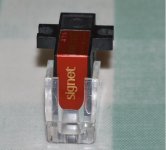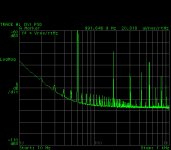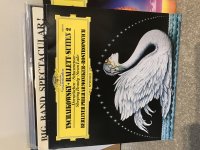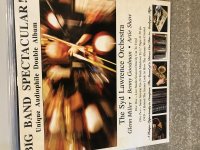Best I post you a couple to try! I personally still think the issue is in the phono stage not the MM cartridge, but I have yet to prove anything on that front.
I bought an expensive cartridge once. Never again.
I can blame someone else for my recent aquisition of this, honest. 4.8g of Audio Technicas finest circa 1980. As a new old stock sony XL-MC5 is some £400 these days this is likely to remain my lightest MC for a long time.
I bought an expensive cartridge once. Never again.
I can blame someone else for my recent aquisition of this, honest. 4.8g of Audio Technicas finest circa 1980. As a new old stock sony XL-MC5 is some £400 these days this is likely to remain my lightest MC for a long time.
Attachments
I still have a AKG P8ES. When AKG eol-ed it, they destroyed all machines
and parts stock to inhibit further gray market sells of over-aged NOS devices.
Maybe the rubber is now hardened enough over the years that it is no longer too soft
for the heavy arm of my Micro Seiki.
and parts stock to inhibit further gray market sells of over-aged NOS devices.
Maybe the rubber is now hardened enough over the years that it is no longer too soft
for the heavy arm of my Micro Seiki.
I don't think the final chapter has been written on Solar Panels for supadup LN yet .. though syn08 has made a good start.Richard said if he was doing it again he'd do it with solar panels instead of batteries. So for the sake of discovery it was done. And proved to be possibly less of a good idea than it first appeared!
_____________________
Guru Wurcer, this is excellent LTspice stuff.
From this, have you got an expression for Common Base Equivalent Input Current Noise? I'm having problems fully understanding the implications of your results with my single senile brain cell.
I'm sure a short tutorial on Equivalent Input Current Noise for Common Base comparing it with Equivalent Input Current Noise for Common Emitter will be greatly appreciated by all here.
______________________
BTW, for those of you who aren't LN gurus, if Guru Wurcer's results are correct in real life, it opens the way for even more easy noise & THD improvement from Duraglit.
I'm trying to dig up 40 yr old memories of practical noise tests with current conducted with an actual Denon DL103 & the Ortofons. So far my notes have only come up with precise details of the 0.28nV/rt(Hz) device which Hans pulled me up on
Richard Lee's Ultra low Noise MC Head Amp
Last edited:
Is that an AT37?I can blame someone else for my recent aquisition of this, honest. 4.8g of Audio Technicas finest circa 1980. As a new old stock sony XL-MC5 is some £400 these days this is likely to remain my lightest MC for a long time.
One of my favourite MC cartridges though I remember it gold coloured. Low output & Z so benefiting greatly from the Duraglit Special
Billshurv, it is in the preamp. I forced mine to play "Brothers in arms" LP with the same treble and bass clarity as the CD.
I have an 1980's MM cart I paid $250 for back then. There appear to be no markings on it but it is audibly better then the Shure R9000 LWS in my LAB500 turntable.
needless to say, the RIAA curve on the preamp is shot to hell. The Sound quality takes on MC quality with a higher S/N.
I have an 1980's MM cart I paid $250 for back then. There appear to be no markings on it but it is audibly better then the Shure R9000 LWS in my LAB500 turntable.
needless to say, the RIAA curve on the preamp is shot to hell. The Sound quality takes on MC quality with a higher S/N.
From this, have you got an expression for Common Base Equivalent Input Current Noise? I'm having problems fully understanding the implications of your results with my single senile brain cell.
I'm sure a short tutorial on Equivalent Input Current Noise for Common Base comparing it with Equivalent Input Current Noise for Common Emitter will be greatly appreciated by all here.
It's (a little simplified) SQRT(2qIc) in A/rtHz. That makes it SQRT(Beta) larger than for the common emitter, where it is is SQRT(2qIb).
Quick justification (draw a schematic of the pi model, or take a look at https://www.uio.no/studier/emner/matnat/ifi/INF5460/h16/undervisningsmateriale/f8-1p.pdf ). The bipolar transistor has (short of Rbb) two shot noise current sources, one in parallel with Rb'e with I^2=2qIb and one in parallel with the controlled current source gm*Ub'e with I^2=2qIc. In common base, when you short the emitter to the base, Ub'e=0, the controlled current source is zero (open) so all that is left to flow to the ground is the 2qIc noise current.
My pluricelular brain has trouble understanding what's so special about that ******* Duraglit, other than it is simple and easy to cobble together.
Last edited:
Scott, 12 mA off a 1.5v battery is very high. I’d be inclined to forego some noise performance for longer battery life.
No that was just an extreme example to show that the matching of input R to cart R is not a noise optimum. If you sweep the bias setting resistor you can show that the noise very slowly increases as the bias current goes down. It is a fairly weak function, that is why the versions at a few 100's of uA are still not bad.
It's (a little simplified) SQRT(2qIc) in A/rtHz. That makes it SQRT(Beta) larger than for the common emitter, where it is is SQRT(2qIb).
Except the complementary circuit with source resistance behaves differently. At 12mA Ic the collector shot noise of each transistor only contributes ~6.5pA rt-Hz to the RTI noise (re: 14 Ohm source resistance).
No that was just an extreme example to show that the matching of input R to cart R is not a noise optimum. If you sweep the bias setting resistor you can show that the noise very slowly increases as the bias current goes down. It is a fairly weak function, that is why the versions at a few 100's of uA are still not bad.
Funny you mentioned this, since I just finished measuring #375 at 200uA collector current. Since 1/2gm=62ohm, RB and the (local) emitter degeneration (now 15ohm) noise contribution can be safely ignored. I got 0.93nV/rtHz, simulation says 0.83nV/rtHz once again the solar cell noise contribution is very small. Overall gain (DUT plus LNA) is 87dB (was 84dB for Ic=5mA). Interesting enough, the noise corner frequency goes down significantly in this consiguration, it is around 60-70Hz vs. 100-200Hz @ Ic=5mA.
So 25 times lower collector current makes the noise about only 3 times larger, not too bad. Something around 1.5nV/rtHz could be fed from one of those isolated gate controller ICs like http://www.vishay.com/docs/84639/vo1263aa.pdf and good bye batteries, solar cells, rechargeables.
P.S. What I mentioned above, for #375 the gain is practically independent on anything but the power supply voltage Gain=(Vcc-Vbe)/Vt Vt=kt/q. For 25 times lower transconductance, the gain actually goes up by 3dB!
Attachments
Last edited:
Except the complementary circuit with source resistance behaves differently. At 12mA Ic the collector shot noise of each transistor only contributes ~6.5pA rt-Hz to the RTI noise (re: 14 Ohm source resistance).
Calculation was for a simple common base stage, not for a complementary common base circuit with emitter degeneration. Apple to apple, the overall complementary common emitter with degeneration is also not SQRT(2qIb).
Last edited:
Best I post you a couple to try! I personally still think the issue is in the phono stage not the MM cartridge, but I have yet to prove anything on that front.
I bought an expensive cartridge once. Never again.
I can blame someone else for my recent aquisition of this, honest. 4.8g of Audio Technicas finest circa 1980. As a new old stock sony XL-MC5 is some £400 these days this is likely to remain my lightest MC for a long time.
That’s very kind of you but I’d never risk your cartridge. I’m the guy that specializes in pulling pins out remember?
The MC head amp feeds directly into the MM stage on my set-up so I am inclined to think it’s the ML cartridge that is better. You can hear it in the low level detail on Orchestral recordings - DG Swan Lake and DG LSO’s Firebird Suite.
- ........DG LSO’s Firebird Suite.
Abbado?
Some of his early work with DG is IMO peerless.
No that was just an extreme example to show that the matching of input R to cart R is not a noise optimum. If you sweep the bias setting resistor you can show that the noise very slowly increases as the bias current goes down. It is a fairly weak function, that is why the versions at a few 100's of uA are still not bad.
Ok - thanks. Got it.
Abbado?
Some of his early work with DG is IMO peerless.
Yes.
Attachments
Here’s some other good ones. The big band one is direct to disc - mics straight to cutting lathe which is a Michael Valentine ‘Chasing the Dragon’ production. He gave a talk on how they did it. None of this multi mic, multi take mix down stuff.
Attachments
Last edited:
It's an MK111E. Same basic generator just a lightweight body. The AT36/37 are also 'mythical' cartridges which sell for far more than they are worth. The 111E is unloved as people don't have ultralight tonearms any more. 18 ohms so the highest Z of all my cartridges.Is that an AT37?
One of my favourite MC cartridges though I remember it gold coloured. Low output & Z so benefiting greatly from the Duraglit Special
That’s very kind of you but I’d never risk your cartridge. I’m the guy that specializes in pulling pins out remember?
The MC head amp feeds directly into the MM stage on my set-up so I am inclined to think it’s the ML cartridge that is better. You can hear it in the low level detail on Orchestral recordings - DG Swan Lake and DG LSO’s Firebird Suite.
As I view damage as a sign its time to modify I'm really not worried. In some cases the running costs of my MCs is potentially less than MMs given Ortofon's stylus prices!
If you don't mind the odd look you should try my stylus 40 on your 2M Gyger stylus.
I'm sure a short tutorial on Equivalent Input Current Noise for Common Base comparing it with Equivalent Input Current Noise for Common Emitter will be greatly appreciated by all here.
I getIt's (a little simplified) SQRT(2qIc) in A/rtHz. That makes it SQRT(Beta) larger than for the common emitter, where it is is SQRT(2qIb)
18.24 * SQRT(Ic) pA/rt(Hz) from my Jurassic notes
Ic in mA
Are my numbers correct? Guru Wurcer?
Scott Wurcer said:Except the complementary circuit with source resistance behaves differently. At 12mA Ic the collector shot noise of each transistor only contributes ~6.5pA rt-Hz to the RTI noise (re: 14 Ohm source resistance).
Can you explain this Guru Wurcer.Using probes to compute the noise gain from voltage at the base of each transistor and the noise gain of the collector shot noise referred to the input current gave interesting results. The noise gain for voltage injected at the base was ½ to the output, which means the effective noise is from RB/4, while the collector shot noise is a factor of 10 lower or the shot noise of Ic/100. These numbers seemed somewhat non-intuitive but plugging in all the numbers gave almost exactly the answer from LTSpice. I think this is a hidden benefit of the floating Leach circuit that I have never seen pointed out.
Are you saying Duraglit doesn't behave like the 'usual' common base stage as it doesn't have the above Equivalent Input Current Noise?
Last edited:
Calculation was for a simple common base stage, not for a complementary common base circuit with emitter degeneration. Apple to apple, the overall complementary common emitter with degeneration is also not SQRT(2qIb).
I think is was Richard's impression that the input current noise of each individual common base stage flows into the source resistance. The problem is similar to the analysis in Alberto Billoti's paper on noise in current mirrors. The collector shot noise divides between the source and the other transistor. With Rin = 14 Ohms and re = 2 Ohms most of it goes into the other emitter which does not contribute to output voltage (it circulates). To avoid the algebra I injected AC current into the input and across one collector to compare the gain to the output and the answer was ~ -20dB so back of the envelope (for this case) the collector shot noise acts like ~Ic/100 at the input.
- Home
- Source & Line
- Analogue Source
- Richard Lee's Ultra low Noise MC Head Amp




